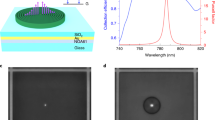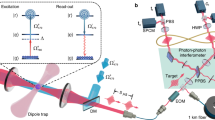Abstract
An optical quantum computer, powerful enough to solve problems so far intractable using conventional digital logic, requires a large number of entangled photons1,2. At present, entangled-light sources are optically driven with lasers3,4,5,6,7, which are impractical for quantum computing owing to the bulk and complexity of the optics required for large-scale applications. Parametric down-conversion is the most widely used source of entangled light, and has been used to implement non-destructive quantum logic gates8,9. However, these sources are Poissonian4,5 and probabilistically emit zero or multiple entangled photon pairs in most cycles, fundamentally limiting the success probability of quantum computational operations. These complications can be overcome by using an electrically driven on-demand source of entangled photon pairs10, but so far such a source has not been produced. Here we report the realization of an electrically driven source of entangled photon pairs, consisting of a quantum dot embedded in a semiconductor light-emitting diode (LED) structure. We show that the device emits entangled photon pairs under d.c. and a.c. injection, the latter achieving an entanglement fidelity of up to 0.82. Entangled light with such high fidelity is sufficient for application in quantum relays11, in core components of quantum computing such as teleportation12,13,14, and in entanglement swapping15,16. The a.c. operation of the entangled-light-emitting diode (ELED) indicates its potential function as an on-demand source without the need for a complicated laser driving system; consequently, the ELED is at present the best source on which to base future scalable quantum information applications17.
This is a preview of subscription content, access via your institution
Access options
Subscribe to this journal
Receive 51 print issues and online access
$199.00 per year
only $3.90 per issue
Buy this article
- Purchase on Springer Link
- Instant access to full article PDF
Prices may be subject to local taxes which are calculated during checkout



Similar content being viewed by others
References
Knill, E., Laflamme, R. & Milburn, G. J. A scheme for efficient quantum computation with linear optics. Nature 409, 46–52 (2001)
Kok, P. et al. Linear optical quantum computing with photonic qubits. Rev. Mod. Phys. 79, 135–174 (2007)
Aspect, A., Grangier, P. & Roger, G. Experimental realization of Einstein-Podolsky-Rosen-Bohm gedankenexperiment: a new violation of Bell’s inequalities. Phys. Rev. Lett. 49, 91–94 (1982)
Shih, Y. H. & Alley, C. O. New type of Einstein-Podolsky-Rosen-Bohm experiment using pairs of light quanta produced by optical parametric down conversion. Phys. Rev. Lett. 61, 2921–2924 (1988)
Kiess, T. E., Shih, Y. H., Sergienko, A. V. & Alley, C. O. Einstein-Podolsky-Rosen-Bohm experiment using pairs of light quanta produced by type-II parametric down-conversion. Phys. Rev. Lett. 71, 3893–3897 (1993)
Edamatsu, K., Oohata, G., Shimizu, R. & Itoh, T. Generation of ultraviolet entangled photons in a semiconductor. Nature 431, 167–170 (2004)
Stevenson, R. M. et al. A semiconductor source of triggered entangled photon pairs. Nature 439, 179–182 (2006)
Gasparoni, P. J.-W., Walther, P., Rudolph, T. & Zeilinger, A. Realization of a photonic controlled-NOT gate sufficient for quantum computation. Phys. Rev. Lett. 93, 020504 (2004)
Zhao, Z. et al. Experimental demonstration of a nondestructive controlled-NOT quantum gate for two independent photon qubits. Phys. Rev. Lett. 94, 030501 (2005)
Benson, O., Santori, C., Pelton, M. & Yamamoto, Y. Regulated and entangled photons from a single quantum dot. Phys. Rev. Lett. 84, 2513–2516 (2000)
Jacobs, B. C., Pittman, T. B. & Franson, J. D. Quantum relays and noise suppression using linear optics. Phys. Rev. A 66, 052307 (2002)
Bennett, C. H. et al. Teleporting an unknown quantum state via dual classical and Einstein-Podolsky-Rosen channels. Phys. Rev. Lett. 70, 1895–1899 (1993)
Bouwmeester, D. et al. Experimental quantum teleportation. Nature 390, 575–579 (1997)
Horodecki, M., Horodecki, P. & Horodecki, R. General teleportation channel, singlet fraction, and quasidistillation. Phys. Rev. A 60, 1888–1898 (1999)
Żukowski, M., Zeilinger, A., Horne, M. A. & Ekert, A. K. “Event-ready-detectors” Bell experiment via entanglement swapping. Phys. Rev. Lett. 71, 4287–4290 (1993)
Pan, J.-W., Bouwmeester, D. & Weinfurter, H. & Zeilinger, A. Experimental entanglement swapping: entangling photons that never interacted. Phys. Rev. Lett. 80, 3891–3894 (1998)
Bennett, C. H. & DiVincenzo, D. P. Quantum information and computation. Nature 404, 247–255 (2000)
Akopian, N. et al. Entangled photon pairs from semiconductor quantum dots. Phys. Rev. Lett. 96, 130501 (2006)
Hafenbrak, R. et al. Triggered polarization-entangled photon pairs from a single quantum dot up to 30 K. N. J. Phys. 9, 315 (2007)
Hudson, A. J. et al. Coherence of an entangled exciton-photon state. Phys. Rev. Lett. 99, 266802 (2007)
Yuan, Z. et al. Electrically driven single-photon source. Science 295, 102–105 (2002)
Young, R. J. et al. Inversion of exciton level splitting in quantum dots. Phys. Rev. B 72, 113305 (2005)
Young, R. J. et al. Bell-inequality violation with a triggered photon-pair source. Phys. Rev. Lett. 102, 030406 (2009)
Michler, P. ed. Single Quantum Dots: Fundamentals, Applications and New Concepts (Springer, 2003)
Young, R. J. et al. Improved fidelity of triggered entangled photons from single quantum dots. N. J. Phys. 8, 29 (2006)
Moreau, E. et al. Quantum cascade of photons in semiconductor quantum dots. Phys. Rev. Lett. 87, 183601 (2001)
Shields, A. J., Stevenson, R. M. & Young, R. J. in Single Semiconductor Quantum Dots (ed. Michler, P.) Ch. 7 (Springer, 2009)
Ekert, A. K. Quantum cryptography based on Bell’s theorem. Phys. Rev. Lett. 67, 661–663 (1991)
Nicoll, C. A. et al. MBE growth of In(Ga)As quantum dots for entangled light emission. J. Cryst. Growth 311, 1811–1814 (2008)
Mohan, A. et al. Polarization-entangled photons produced with high-symmetry site-controlled quantum dots. Nature Photon advance online publication, 10.1038/nphoton.2010.2 (7 March 2010)
Acknowledgements
We would like to acknowledge funding for this work from the Engineering and Physical Sciences Research Council, the Quantum Information Processing Interdisciplinary Research Collaboration, the EU Integrated Projects, Qubit Applications and Quantum Interfaces, Sensors and Communication based on Entanglement and Nanoscience in the European Research Area, and we thank K. Cooper for his advice and support in device fabrication.
Author information
Authors and Affiliations
Contributions
C.L.S. and R.M.S. performed measurements and analysis with support from other authors. All authors contributed to the heterostructure design. The heterostructures were grown by I.F., C.A.N. and D.A.R. LEDs were processed by C.L.S. This work was directed by A.J.S. All authors contributed to writing the manuscript.
Corresponding authors
Ethics declarations
Competing interests
The authors declare no competing financial interests.
Rights and permissions
About this article
Cite this article
Salter, C., Stevenson, R., Farrer, I. et al. An entangled-light-emitting diode. Nature 465, 594–597 (2010). https://doi.org/10.1038/nature09078
Received:
Accepted:
Issue Date:
DOI: https://doi.org/10.1038/nature09078
This article is cited by
-
Nonlocal interaction enhanced biexciton emission in large CsPbBr3 nanocrystals
eLight (2023)
-
Applications of single photons to quantum communication and computing
Nature Reviews Physics (2023)
-
Highly stable and pure single-photon emission with 250 ps optical coherence times in InP colloidal quantum dots
Nature Nanotechnology (2023)
-
Structural and compositional analysis of (InGa)(AsSb)/GaAs/GaP Stranski–Krastanov quantum dots
Light: Science & Applications (2021)
-
Quantum-dot-based deterministic photon–emitter interfaces for scalable photonic quantum technology
Nature Nanotechnology (2021)
Comments
By submitting a comment you agree to abide by our Terms and Community Guidelines. If you find something abusive or that does not comply with our terms or guidelines please flag it as inappropriate.



